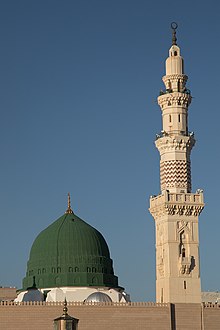This is an old revision of this page, as edited by FrescoBot (talk | contribs) at 05:04, 4 July 2020 (Bot: galleries syntax and minor changes). The present address (URL) is a permanent link to this revision, which may differ significantly from the current revision.
Revision as of 05:04, 4 July 2020 by FrescoBot (talk | contribs) (Bot: galleries syntax and minor changes)(diff) ← Previous revision | Latest revision (diff) | Newer revision → (diff) For the Abbasid palace in Baghdad, see Palace of the Golden Gate.
The Green Dome (Template:Lang-ar) is a green-coloured dome built above the tomb of the Islamic prophet Muhammad and early Muslim Caliphs, Abu Bakr and Umar. The dome is located in the south-east corner of Al-Masjid al-Nabawi (Mosque of the Prophet) in Medina.
The structure dates back to 1279 CE, when an unpainted wooden cupola was built over the tomb. It was later rebuilt and painted using different colours twice in the late 15th century and once in 1817. The dome was first painted green in 1837, and hence became known as the Green Dome.
History
Built in 1279 CE or 678 AH during the reign of Mamluk Sultan Al Mansur Qalawun, the original structure was made out of wood and was colourless, painted white and blue in later restorations. After a serious fire struck the Mosque in 1481, the mosque and dome had been burnt and a restoration project was initiated by Sultan Qaitbay who had most of the wooden base replaced by a brick structure in order to prevent the collapse of the dome in the future, and used plates of lead to cover the new wooden dome. The building, including the Tomb of the Prophet, was extensively renewed through Qaitbay's patronage. The current dome was added in 1818 by the Ottoman Sultan Mahmud II. The dome was first painted green in 1837.
When Saud bin Abdul-Aziz took Medina in 1805, his followers, the Wahhabis, demolished nearly every tomb dome in Medina based on their belief that the veneration of tombs and places claimed to possess supernatural powers is an offense against tawhid. Muhammad's tomb was stripped of its gold and jewel ornaments, but the dome was preserved either because of an unsuccessful attempt to demolish its hardened structure, or because some time ago Ibn Abd al-Wahhab wrote that he did not wish to see the dome destroyed despite his aversion to people praying at the tomb. Similar events took place in 1925 when the Saudi militias retook—and this time managed to keep—the city. In 2007, according to The Independent, a pamphlet endorsed by the grand mufti of Saudi Arabia and published by the Saudi Ministry of Islamic Affairs stated that "the green dome shall be demolished and the three graves flattened in the Prophet's Masjid". However, due to fear of extreme backlash and apprehended massive protests worldwide, it can not be implemented.
Tomb of Muhammad

Muhammad's grave lies within the confines of what used to be his and his wife Aisha's house, the Hujra. During his lifetime it adjoined the mosque. The mosque was expanded during the reign of Caliph al-Walid I to include his tomb. Muhammad's grave is an important reason for the particular high sanctity of the mosque, as the Dome of the Prophet marks the location of the tomb. Millions visit it every year, since it is a tradition to visit the mosque after the pilgrimage to Mecca.
The first two Caliphs, Abu Bakr and Umar are buried next to Muhammad. Umar was given a spot next to Muhammad by Aisha, which had originally been intended for her. Muhammad's grave itself cannot be seen as the area is cordoned off by a gold mesh and black curtains
Panorama

Gallery
-
 The Green Dome, in Richard Francis Burton's Pilgrimage, ca. 1850 CE
The Green Dome, in Richard Francis Burton's Pilgrimage, ca. 1850 CE
-
 The grave of Muhammad located inside the quarter seen here.
The grave of Muhammad located inside the quarter seen here.
See also
- Burial places of founders of world religions
- Destruction of early Islamic heritage sites in Saudi Arabia
References
- ^ Petersen, Andrew (11 March 2002). Dictionary of Islamic Architecture. Routledge. p. 183. ISBN 9780203203873.
- ^ Ariffin, Syed Ahmad Iskandar Syed (2005). Architectural Conservation in Islam : Case Study of the Prophet's Mosque. Penerbit UTM. pp. 88–89, 109. ISBN 9789835203732.
- "Prophet's Mosque". ArchNet. Archived from the original on 23 March 2012. Retrieved 13 April 2012.
- "The history of Green Dome in Madinah and its ruling". Peace Propagation Center. 4 June 2009. Archived from the original on 24 August 2011. Retrieved 13 April 2012.
- *Meinecke, Michael (1993). Mamlukische Architektur. Vol. 2. pp. 396–442. Meinecke, ', II..
- Peskes, Esther (2000). "Wahhābiyya". Encyclopaedia of Islam. Vol. 11 (2nd ed.). Brill Academic Publishers. pp. 40, 42. ISBN 9004127569.
- Mark Weston (2008). Prophets and princes: Saudi Arabia from Muhammad to the present. John Wiley and Sons. pp. 102–103. ISBN 978-0-470-18257-4.
- Mark Weston (2008). Prophets and princes: Saudi Arabia from Muhammad to the present. John Wiley and Sons. p. 136. ISBN 978-0-470-18257-4.
- Vincent J. Cornell (2007). Voices of Islam: Voices of the spirit. Greenwood Publishing Group. p. 84. ISBN 978-0-275-98734-3.
- Carl W. Ernst (2004). Following Muhammad: Rethinking Islam in the Contemporary World. Univ of North Carolina Press. pp. 173–174. ISBN 978-0-8078-5577-5.
- Jerome Taylor (24 September 2011). "Mecca for the rich: Islam's holiest site 'turning into Vegas'". The Independent. independent.co.uk. Retrieved 13 April 2012.
- ^ "Important Sites: The Prophet's Mosque". Inside Islam. 16 February 2012. Retrieved 13 August 2018.
24°28′03.22″N 039°36′41.18″E / 24.4675611°N 39.6114389°E / 24.4675611; 39.6114389 (Green Dome)
Categories: